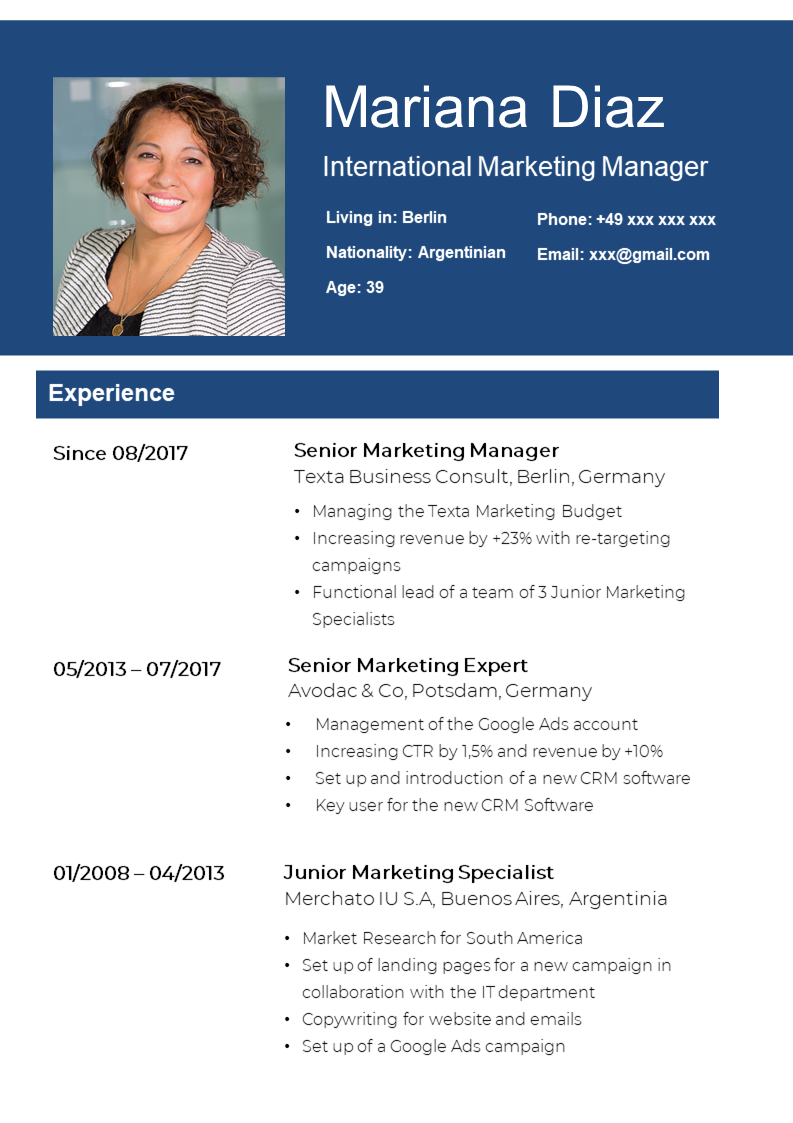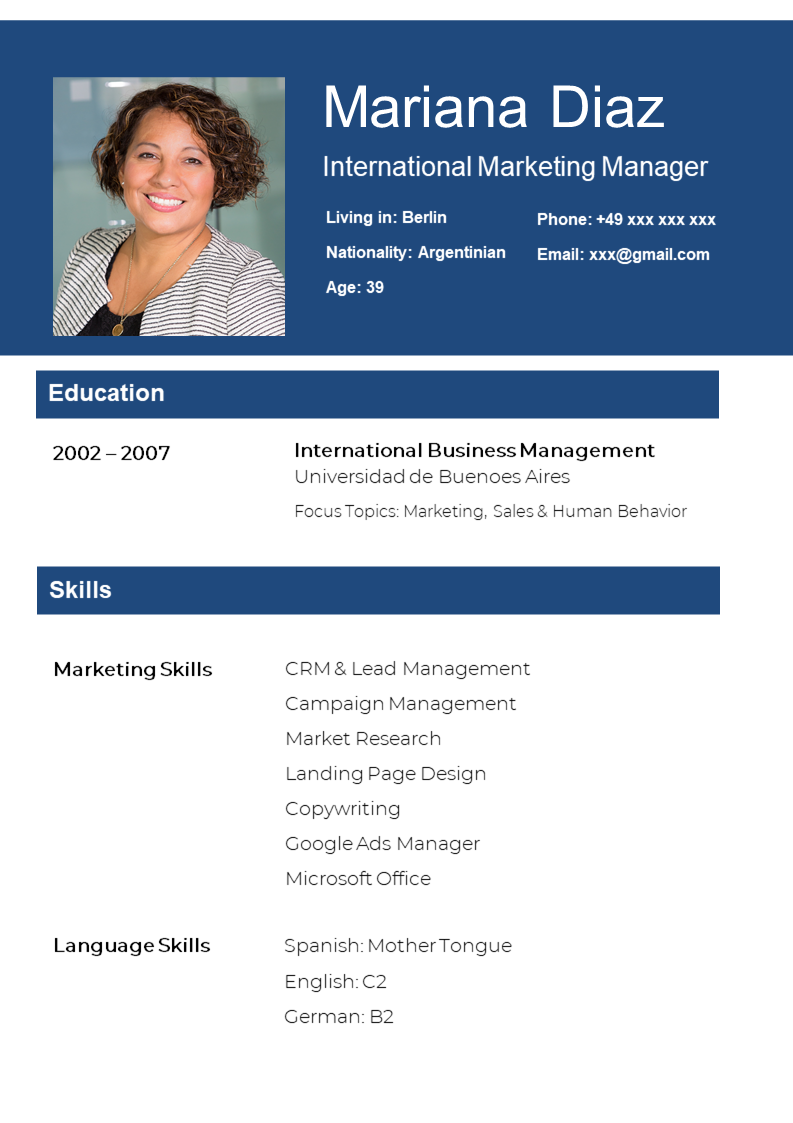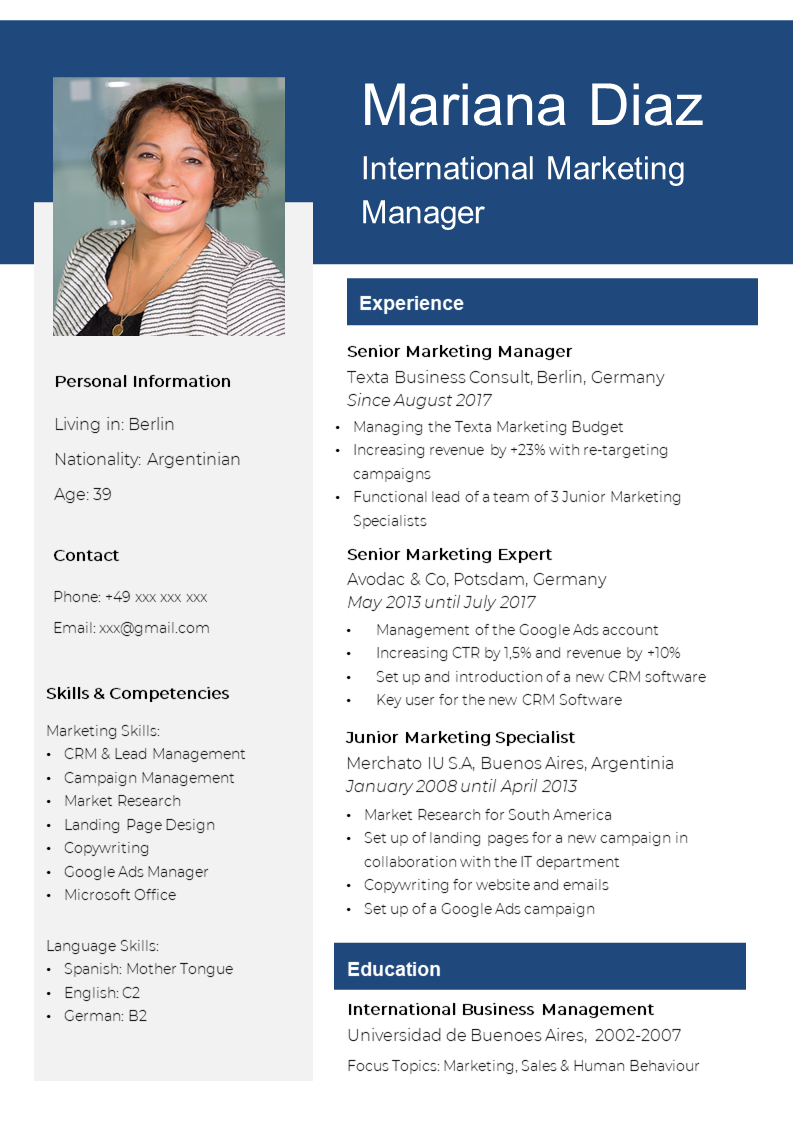Are you looking for a job in Germany but are unsure how you should write your CV? In this article, you will find the most important aspects for writing a CV when applying to jobs in Germany. And at the end, you will also find a secret tip that will make your CV stand out from the crowd.
A guide for your CV in Germany
A typical German CV includes information about who you are and what skills and experience you bring to the table. It’s probably the most important document in your application. With the CV, the company wants to get to know you and make an informed decision if they should invite you for an interview.
Keep in mind for whom you’re writing the CV. Most of the time, managers or HR people in the company will only review your CV for a few seconds before making a decision. Thus, it’s important that you leave a very good first impression and present all the relevant information in an easy to read way.
Specifically, your CV should include the following information:
Personal Details
- Your name and surname
- Your current address or location of living
- Your nationality
- Your age or date of birth
- Your contact information (email or phone number)
- A photo of yourself (professional but smiling)
- Optional: A small summary of your professional profile
Job Experience
- List your professional experiences in reverse chronological order (starting with your latest experience)
- Mention the name of the company you worked for, your job title and specify the time frame when you worked there
- Add 3-5 bullet points per experience and describe what tasks you worked on and what results you achieved
Education
- List your professional education in reverse chronological order
- Include the name of your school or university
- Describe your field of studies and include some topics you focused on
Skills
- List the skills that you have acquired including any technical and job-related skills as well as language skills
- You can also include a self-assessment of your skill level for each skill, for example the Common European Framework of Reference for Languages for your language skills (A1 to C2).
The layout of your CV
Now that you know which information should be included, let’s talk about the layout and the design of your CV.
In general, you have two options: A one column layout or a two column layout.
The one column layout
The one column layout means that all the text in your document is organized into one column and all the information is below each other, not next to each other.
This layout has some advantages when uploading your CV into a recruitment software because typically, the automated scanning and parsing of your information will go more smoothly with a one column layout.
The disadvantage of the one column layout is that you will have a lot of unused white space. Thus, one column layout CVs will usually require 2-3 pages and are hard to fit on only one page. This makes it harder to find all the relevant information at one glance.
Here is an example of a one column layout CV.
The first page describes the experience:

The second page details the education and the skills:

The two column layout
In the two column design, you create two different sections with information next to each other.
This way, you make better use of the space in your CV and it’s easier to keep all the information on just one page. It’s the preferred choice if you want to create one of those nice looking one-pager CVs that stand out with a beautiful design.
The disadvantage is that recruitment software can have a harder time extracting the information and you might encounter more parsing errors that you have to manually correct.
Here is an example of a two page column design:

One vs. two column CV layout: Which to use?
The decision is of course up to you, but we usually recommend a two column CV layout. It allows you to present all your information at one glance and creates a very good first impression.
If you’re concerned about encountering parsing errors when uploading your CV into a recruitment system or you have a lot of experience that doesn’t fit on only one page anyhow, then you might want to use a one column layout.
In the end it also comes down to personal preference. You should use whichever layout you like better and feel more comfortable and confident with.
The right format and software for creating your CV
Most people still use classical word processing software like Microsoft Word for creating their CV. However, it’s usually more difficult to create a nice looking layout and design in such software.
You can also use software that gives you more control over the design process, for example Microsoft Powerpoint or Canva.
Important is that you later export your CV as a PDF-document and use this file for your application.
Secret tip from German recruiters: Personalizing your CV
What is one final tip that can make your CV stand out from the crowd? As recruiters, we believe that it’s the personalization of your CV, that means adjusting your CV for every application slightly to the addressee.
So who is the addressee in your case? The person who will make the decision of whether to invite you to an interview – probably a recruiter working in the HR department or a manager.
So how can you personalize your CV for them?
The best way is to use the keywords that you find in the job posting. Read the job posting carefully and identify what the main keywords are they will be looking for when reviewing your CV. Make sure to include those keywords in your CV so that the recruiter or manager can find them easily. This way they can understand quickly that you are the right fit for the job.
Conclusion: How to write a CV for your applications in Germany
When writing your CV in Germany, you should strive to create a very good first impression. Add your personal information, your experience and education, and your skills. Create a nice looking layout, and in the end, personalize your CV for each job you apply to by adding the relevant keywords from the job posting.
We hope these tips will help you! And if you want more support to create a CV that German recruiters will love, we recommend our CV optimization coaching to you. You can book your slot here.


